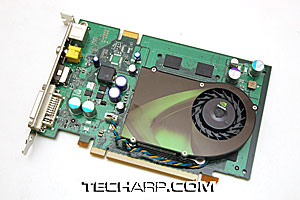| NVIDIA GeForce 8600 GT Graphics Card |
|
The NVIDIA GeForce 8600 GT does offer DirectX 10 support on a low budget. However, its DirectX 10 performance is so abysmal, it is virtually useless at all but the lowest resolutions. Short of some miraculous driver optimizations, there is no way you can run any DirectX 10 game with a usable frame rate at resolutions of 1280 x 1024 or greater. The only possible use for its DirectX 10 support is in games that have very minimal use of DirectX 10 features, like BioShock. In Company Of Heroes, switching to the DirectX 10 render path killed its frame rate from 89 fps to just 35 fps at 800 x 600. Although that is a playable frame rate, it came at the cost of using a very low resolution. As Company Of Heroes is hardly a very graphics-intensive game, we expect even poorer performance with more graphics-intensive DirectX 10 titles. In fact, the GeForce 8600 GT had trouble delivering a good frame rate for more graphics-intensive DirectX 9 titles. In BioShock, the GeForce 8600 GT only managed to deliver a frame rate of 24 fps at 1280 x 1024. BioShock was only playable at lower resolutions of 1024 x 768 or 800 x 600. That is not very surprising though, since the GeForce 8600 GT is really not much faster than the GeForce 7600 GT. In fact, it is slower than higher-end DirectX 9 cards like the NVIDIA GeForce 7950 GT and the ATI Radeon X1950 GT. The only performance advantage the GeForce 8600 GT has over its predecessor is in texture fillrate, where it has a 28.6 % higher fillrate than the GeForce 7600 GT. Both cards have the same memory bandwidth of 22.4 GB/s. This was confirmed by our benchmark results where the GeForce 8600 GT was only 17-30 % faster than the GeForce 7600 GT. So, what is the NVIDIA GeForce 8600 GT good for? This card runs best in DirectX 9 and at lower resolutions like 800 x 600 or 1024 x 768. If you are using a lower-end card like the GeForce 7600 GS or the GeForce 7300 cards, the NVIDIA GeForce 8600 GT offers a good upgrade but only for its DirectX 9 performance. Its DirectX 10 performance is just too abysmal to matter, unless you are stuck with a 15" CRT monitor. If you have a faster GeForce 7-series card like the GeForce 7600 GT, it would not make much sense upgrading to the GeForce 8600 GT. It would be much better to upgrade to a faster GeForce 8-series card that would not only be able to offer a significant performance boost, but also usable frame rates in DirectX 10 games. The new NVIDIA GeForce 8800 GT would be a very good choice. It offers not only a tremendous amount of performance, it is only cost twice as much as the GeForce 8600 GT. For more details, read our Comprehensive Review! |
| MSRP |
• $109 |
Lowest PriceGrabber Price |
|
| Review |
|
Manufacturing Process |
• 0.08 Micron |
Transistor Count |
• 289 Million |
DirectX Support |
• 10 |
Interface |
• PCI Express X16 |
Stream Processors |
• 32 |
Vertex Shader Version |
• 4.0 |
Pixel Shader Version |
• 4.0 |
Textures Per Clock |
• 16 |
ROPs |
• 8 |
Core Clock Speed |
• 540 MHz |
Shader Clock Speed |
• 1190 MHz |
Fill Rate |
• 8640 MTexels/s |
Memory Bus Width |
• 128-bits |
Memory Size |
• 256 MB |
Memory Type |
• GDDR3 |
Memory Speed |
• 700 GHz (1.4 GHz DDR) |
Memory Bandwidth |
• 22.4 GB/s |
DVI Support |
• Single dual-linked DVI, integrated into the GPU |
Our Review System
Tech ARP is committed to developing new ways to improve your experience with us. As part of our continuous efforts to improve the value of our reviews to you, we are implementing a multi-tier review system.
This review system is designed to allow you to quickly receive information on the latest hardware or software. This new system also allows you to quickly get the gist of the review without reading through it. This can be very useful, especially in situations where you need to make a quick purchase decision.
In this new system, we start with a Product Overview whenever a company sends us a press release about their latest product. We shift through extraneous PR-talk to create a straightforward summary of the product's features as well as specifications. This allows you to quickly find out all the pertinent details about the product, without reading through official press releases.
When we receive the product for review, we will quickly take photos of it and create a Pictorial Review. The purpose of a pictorial review is to allow you, the reader, to quickly examine the product visually. It may help you make better purchase decisions, especially if you cannot wait for the full review.
After thorough testing, we will post a Comprehensive Review of the product. This adds on to the pictorial review with comprehensive test results and our final conclusion on the product.
But no matter whether you are reading a Pictorial Review or a Comprehensive Review, you can always read the summary of the review as well as examine the product's specifications right on the first page. In all our new reviews, we will maintain the first page as a Product Overview page. If the product is listed in PriceGrabber, you can also check out the lowest price online.
We hope this new review system will make your experience a lot more enjoyable and informative!







 Add to Reddit
Add to Reddit

